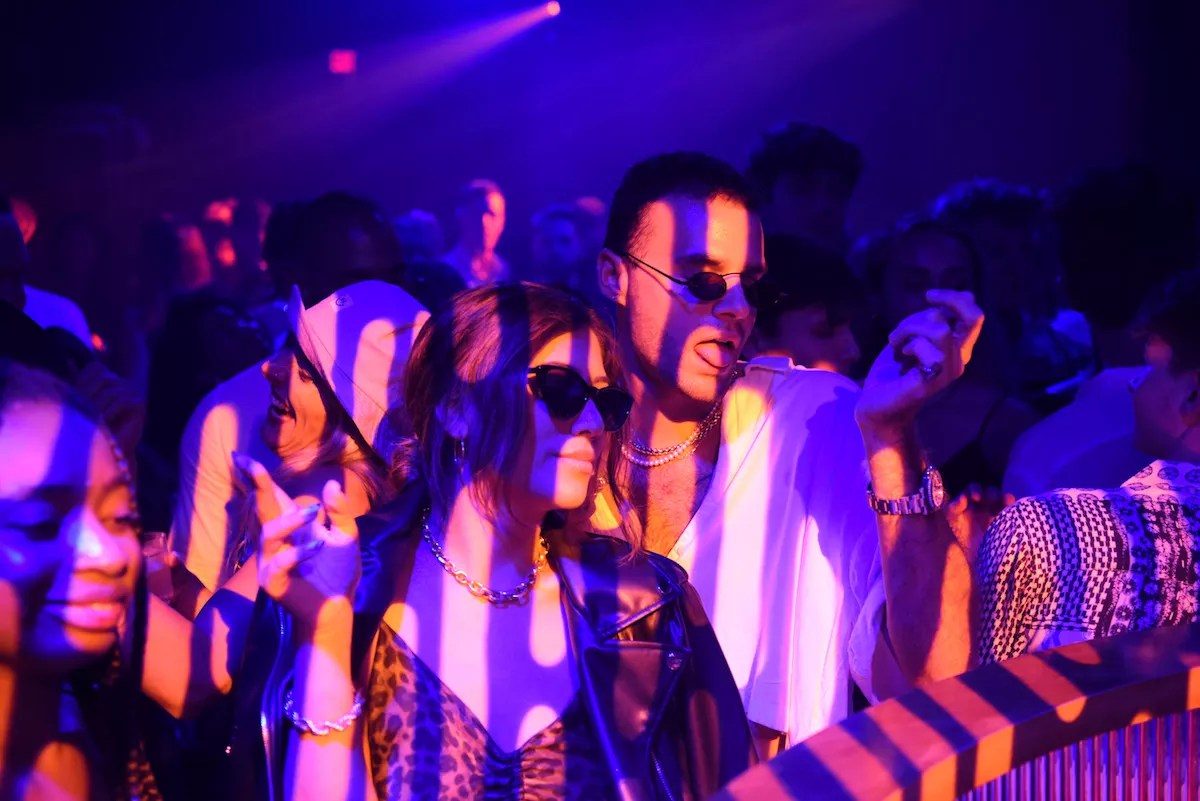
Photo by Michele Eve Sandberg

Audio By Carbonatix
The party starts late in Miami, but a little past 10 p.m. on a Saturday night, Wywnood’s already bustling. Cars are bumper to bumper on NW Second Avenue, windows rolled down, blasting the communal soundtrack of reggaeton and rap. Thumping party buses clog traffic as passengers drape out of the windows with bottles of Champagne. Women in bodycon dresses and heels gleefully skip down 24th Street, only to be brought up short by entry lines that snake around corners. Men in button-down tops and slacks vape while chilling in line, adhering to bouncers’ “no shorts for men” mandate.
Is anyone here for the art?
Once just an aggregation of unassuming warehouses, Wynwood was intentionally reimagined to form one of the world’s grittiest and most beloved art districts. But of the 70 galleries, collections, and museums that were once based here, only 15 remain – long since outnumbered by the bars, clubs, and restaurants. Colorful murals still splay across exterior walls, a popular backdrop for selfies and photos. These days locals and tourists flock to Wynwood to eat, drink, and, more recently, to party. In the wake of COVID-19 lockdowns, the neighborhood has mutated into a flashy nightlife destination. Club owners, though, fear their reign will be short-lived and that they’ll suffer a fate like that of the galleries before them: the cranes and towering constriction of more than a dozen condos foreshadowing perhaps the next iteration of Miami’s fastest-evolving ‘hood: residential.
“I’ve never seen so many buildings coming in at once in Wynwood, and what is crazy is that they’re building super fast – in a year the thing is built,” says Philippe Kalifa, owner of El Patio and Mayami Mexicantina. “Once [developers] set a pin on the neighborhood, they’re gonna get it. I’m not very optimistic.”
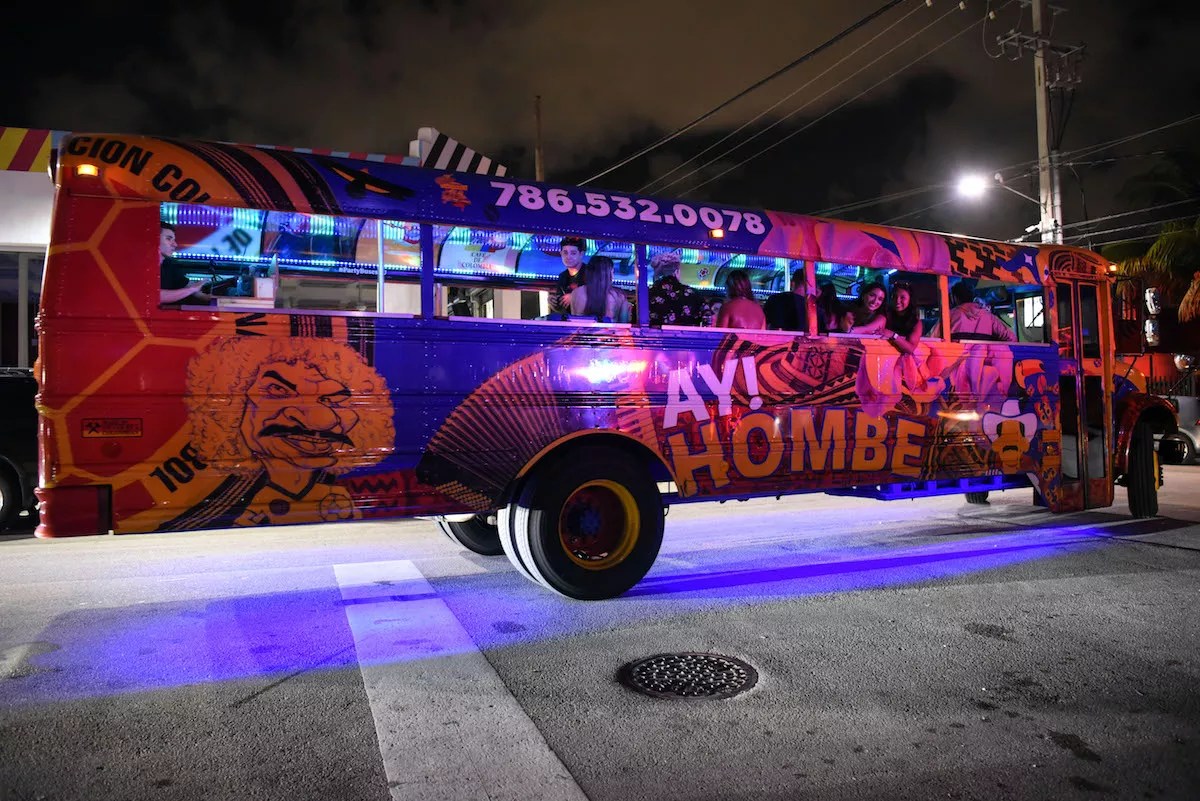
Party buses clog traffic on NW Second Avenue. See more photos from Wynwood’s nightlife scene here.
Photo by Michele Eve Sandberg
How It Started
Wynwood has changed several times since its inception, perhaps more than any other neighborhood in Miami. Known as a garment district in the early 1920s, it was packed with massive warehouses and factories housing shoe manufacturers and button retailers. Residents were primarily working-class until the 1950s, when the construction of I-95 uprooted those families to the suburbs and Miami’s version of Mayberry. Around this time, a large number of Puerto Ricans moved to Wynwood, eventually earning the the neighborhood the nickname “Little San Juan.” Throughout the late 1970s and early 1980s, the area fell into disrepair, with drugs, violence, and poverty running rampant.
“In the 1980s, Wynwood was the most dangerous place in Miami,” gallerist Harold Golen remembers.
Golen, whose gallery is situated on NW Second Avenue just south of 23rd Street, adds that back then, lost tourists hoping to find Miami Beach would accidentally end up in Wynwood. Their sunburns and accents revealed that they weren’t from around here, and Golen says they were often robbed and sometimes even killed. “It happened so many times,” he adds, “that there was a punk rock band around that time named Dead German Tourist.”
By the mid- to late 1990s, it seemed the only direction the neighborhood could go was up. Although it was still dangerous, some galleries took up warehouses, baited in by the attractive prices and large spaces.
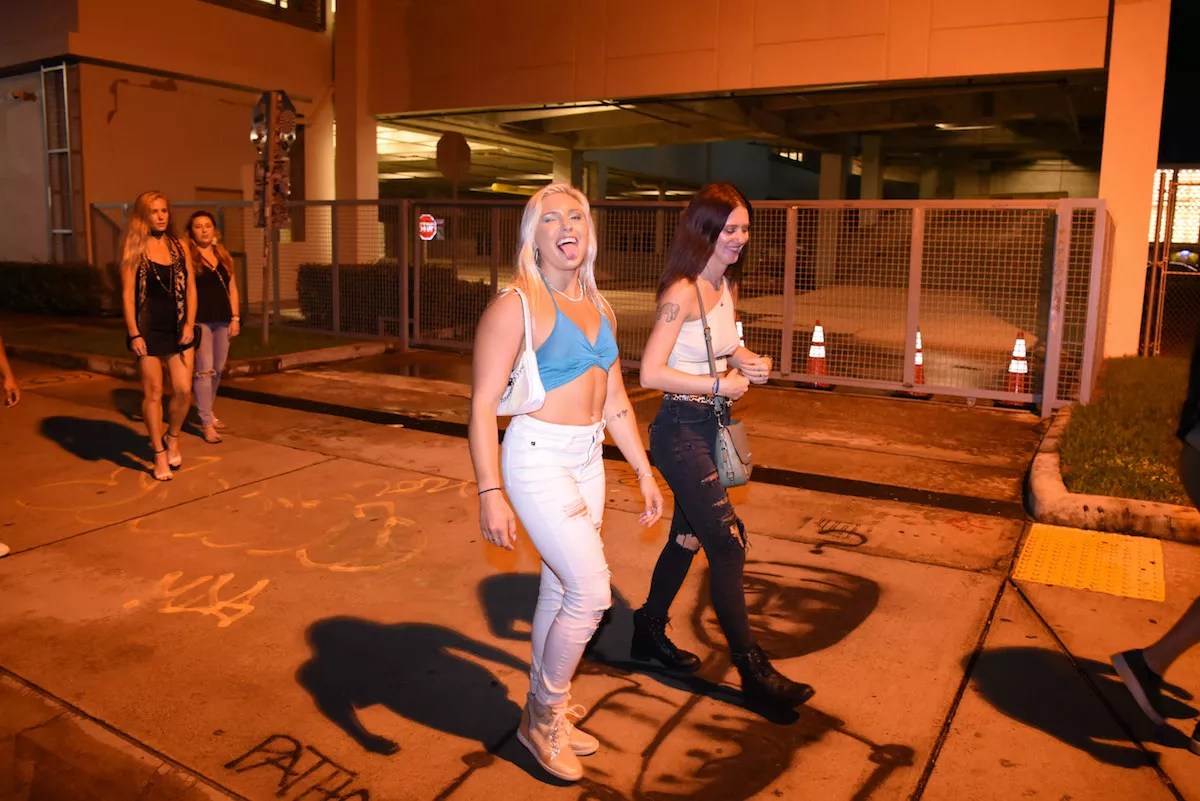
Is anyone here for the art? See more photos from Wynwood’s nightlife scene here.
Photo by Michele Eve Sandberg
Phase 1: Galleries
One of the first people to move in with massive sculptures and paintings was a prominent art-collecting couple from New York, Mera and Don Rubell. In 1993, they opened the Rubell Family Collection in a 40,000-square-foot fortress, for the price of a one-bedroom apartment in New York. The space was formerly a U.S. Drug Enforcement Administration warehouse.
The Rubells were instrumental in transforming Wynwood into an art district. After years of attending Art Basel in Switzerland, they pushed for the annual art fair to come to Miami. It was their son, Jason Rubell, who came up with the notion to use shipping containers to display art on the sand in Miami Beach. Art Basel’s director at the time loved the idea, and in 2002 the fair debuted in the Magic City, essentially putting it on the international art-world map.
It wasn’t long before this renown trickled to the mainland, and specifically to Wynwood. More galleries popped up at the turn of the millennium – Emerson Dorsch gallery in 2000, David Castillo gallery in 2005, Pan American Art Projects in 2006, Gallery Diet (now Nina Johnson Gallery) and Harold Golen in 2007, and many others. The gallerists opened their doors for the Second Saturday art walk, which also appeared around this time and is credited with luring the city’s culture-minded residents to a neighborhood many avoided, especially at night.
In the mid-2000s, Tony Goldman, a well-known real estate developer, set his sights on Wynwood, purchasing buildings in the neighborhood and renovating them into hip, modern spaces. In 2008, he opened Joey’s Italian Cafe at NW Second Avenue and 25th Street, the first restaurant in the neighborhood.
He also conceptualized and opened the now-world-famous Wynwood Walls in 2009. (It’s where Miami hospitality mogul David Grutman would later marry his partner, Isabela Rangel, with Kim and Kanye in attendance.)
It wasn’t long before Wynwood became known as an art district, attracting millions of visitors who, drawn to the eye-grabbing murals, considered the entire neighborhood a free outdoor art museum.
But the inception wasn’t without its hiccups. In 2011, diners at Joey’s were held up at gunpoint as three masked bandits confiscated cell phones and cash from the register.
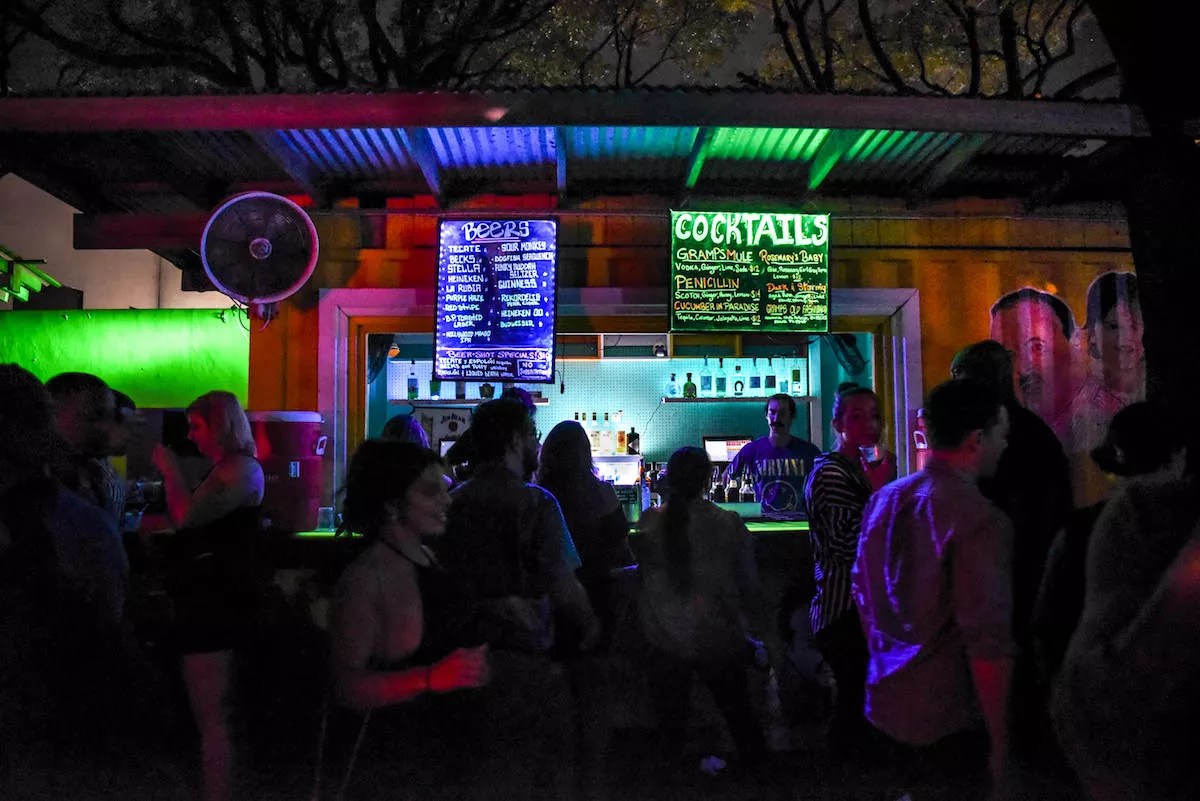
Gramps is one of the remaining bars in the neighborhood that have yet to institute a cover charge. See more photos from Wynwood’s nightlife scene here.
Photo by Michele Eve Sandberg
Phase II: Restaurants
In the 2010s, Wynwood was hip yet still somewhat art-focused. People didn’t just come for galleries and street art; they started frequenting the small shops, breweries, bars, and cafés that came to line the blocks.
Lester’s opened in 2010 on NW Second Avenue, as did Panther Coffee’s first outpost. Wood Tavern opened in 2011, Gramps in 2012. A more underground, artsy crowd tended to congregate, and Wynwood was deemed the city’s “hipster” hangout.
When it opened in 2015, chef Brad Kilgore’s Alter quickly became one of the swankiest restaurants in town. Known for its meticulous plating, Alter nabbed Kilgore a finalist spot the following year for the James Beard Foundation’s Best New Restaurant in the nation.
The food scene gained traction with the subsequent openings of restaurants like Kush and Coyo Taco in 2015, and Kyu in 2016.
One at a time, priced-out gallerists began packing their canvases: Frederic Snitzer and David Castillo in 2014, Nina Johnson and Emerson Dorsch in 2015, Pan-American Projects in 2016. The Rubell Family Collection departed in 2019.
“My business had to evolve because people weren’t just coming for the art anymore.”
Harold Golen is one of the few remaining gallerists in Wynwood. He explains that as the neighborhood welcomed in more businesses and developers continued to buy up buildings, the rent increased dramatically, pushing out gallerists to more affordable areas like Little River near 79th Street. Visitors to Wynwood changed as well; they became younger and keener on shopping at retail boutiques and grabbing a bite to eat.
“My business had to evolve because people weren’t just coming for the art anymore,” Golen says. “People walking around with bags from cool clothing stores would come into my gallery – and yes, they liked the art, but they couldn’t afford it.”
He says that his gallery is more of a store now. Although he still sells artworks, he no longer hosts openings. His inventory has expanded to include more affordable items like vinyl figures, T-shirts, postcards, stickers, books, and other novelty merchandise. Kawaii Universe, a brand that once had its own store/gallery a few blocks from Golen, is now part of his gallery as well. He says business has been good overall.
“I’m doing the best business I ever did because I have what these people are looking for. I always try to find the coolest stuff,” Golen says. “People appreciate that and I have repeat customers all of the time.”
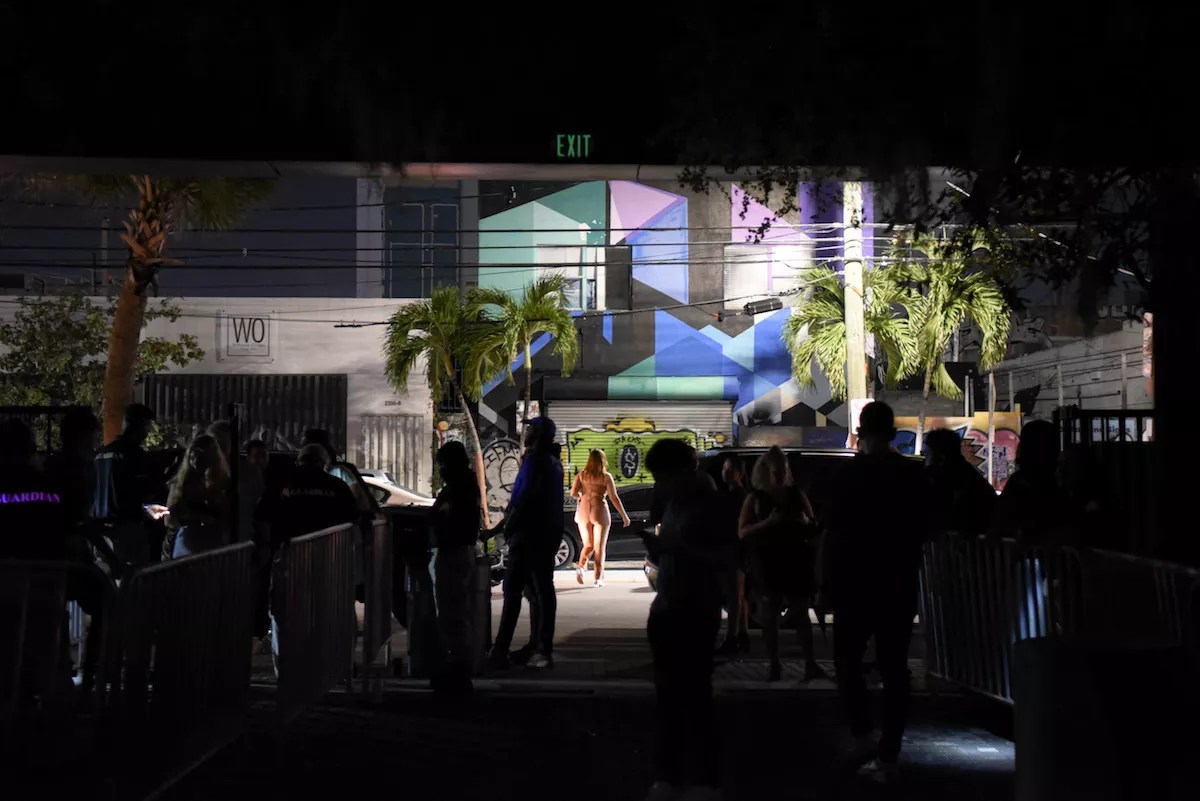
Clubgoers endure long lines to enter venues. See more photos from Wynwood’s nightlife scene here.
Photo by Michele Eve Sandberg
Phase III: Bars
Wynwood was once known for its cheap beer, good music, and no cover charge. It was a spot where coworkers could stop by after work for a casual happy hour, or where music aficionados could flock to catch sets by live bands.
Two high-profile closings are altering that vibe: Electric Pickle, which opened in 2009, was Wynwood’s longest-running nightclub when closed in 2019 owing to rising rent and shifting customer preferences. Wood Tavern closed this past March, with owner Cesar Morales citing financial strain from the pandemic.
Morales says Wood Tavern’s tenure saw the neighborhood’s profile shift dramatically.
“You look at the timeline and it was just so quick,” Morales tells New Times. “It was put on the global map, the art scene, and then three, four years ago you started having the tour buses come to see all of the art, which is a cool thing, but that just made all the real estate investors make the property [values] go up, and from there everything starts.”
Morales expresses amazement at how quickly the art galleries, mom-and-pop shops, and many of the bars disappeared, replaced by “glass buildings and fancy this, fancy that.”
He understands, though, that business is business.
“I’m saddened by it but I’m not mad by it. Hey, if I had a property I bought for half a million dollars and someone came out with $5 million, you can’t hate on me for accepting the $5 million,” he says. “And so I don’t hate on anybody. I get it. But it is unfortunate. It is sad for the community.”
Morales moved Wood Tavern out of its former location but was able to give his bar new life a stone’s throw away at his new establishment Pizza & Beer on 23rd Street. He reopened phase one of the new Wood on July 11. Loyal patrons showed up to the opening, looking to fill the “void” present in Wynwood.
Gramps is another neighborhood veteran that has managed to stick around in its original incarnation since opening in 2012, advertising “air conditioning, cold beer, and cocktails” on its tangerine-hued exterior. Longtime patrons come to quaff affordably priced beers and cocktails outdoors and to catch live music, comedy, and drag shows.
“I’ve seen [most of] the galleries are gone, some of the first waves of bars and restaurants are gone.”
Growing up in Miami Beach, Gramps owner Adam Gersten has a lifelong relationship with gentrification.
“I watched a sleepy small town that was in a huge recession, in bad shape, turn around and become that crazy nightlife destination,” he says of Miami Beach. “It’s also something I’ve lived through in another place.”
The neighborhood Wynwood was in 2012 when Gersten opened his bar is unrecognizable today.
“I’ve seen [most of] the galleries are gone, some of the first waves of bars and restaurants are gone,” he says. “It’s Miami – we’re always knocking stuff down and putting stuff up.”
Rents have climbed and the area has changed so much that Gersten doesn’t see how opening a bar like Gramps would be feasible on today’s landscape. But as one of the last holdouts -and blessed with loyal patrons – Gersten hopes his bar will be able to stick around, even with its (mostly) free cover and affordable drinks.
“As long as I’m able to, I would like to maintain [that price point] in Wynwood,” he says. “I don’t know if I can maintain that, but I’m very hopeful that there’s a way I can do that. Because it is important. It tells people: There’s the perception that Gramps is a safe place, a place you can be yourself and not have to think a lot about showing up.”
The new nightlife attractions that surround Gramps don’t attract the same crowd his bar does – and he’s OK with that. Although everything around him may be changing, he hopes his bar will continue to honor the original essence of the neighborhood.
Fernando Antonio is a 30-year-old attorney who began frequenting Wynwood around 2013, frequenting Electric Pickle and Wood Tavern.
“I’ve always noticed things changing in Wynwood,” Antonio says. “But I really noticed the changes back in March when I was going out. I was trying to go to a couple of bars and they had cover charges and lines, and I was like, ‘What the heck?'”
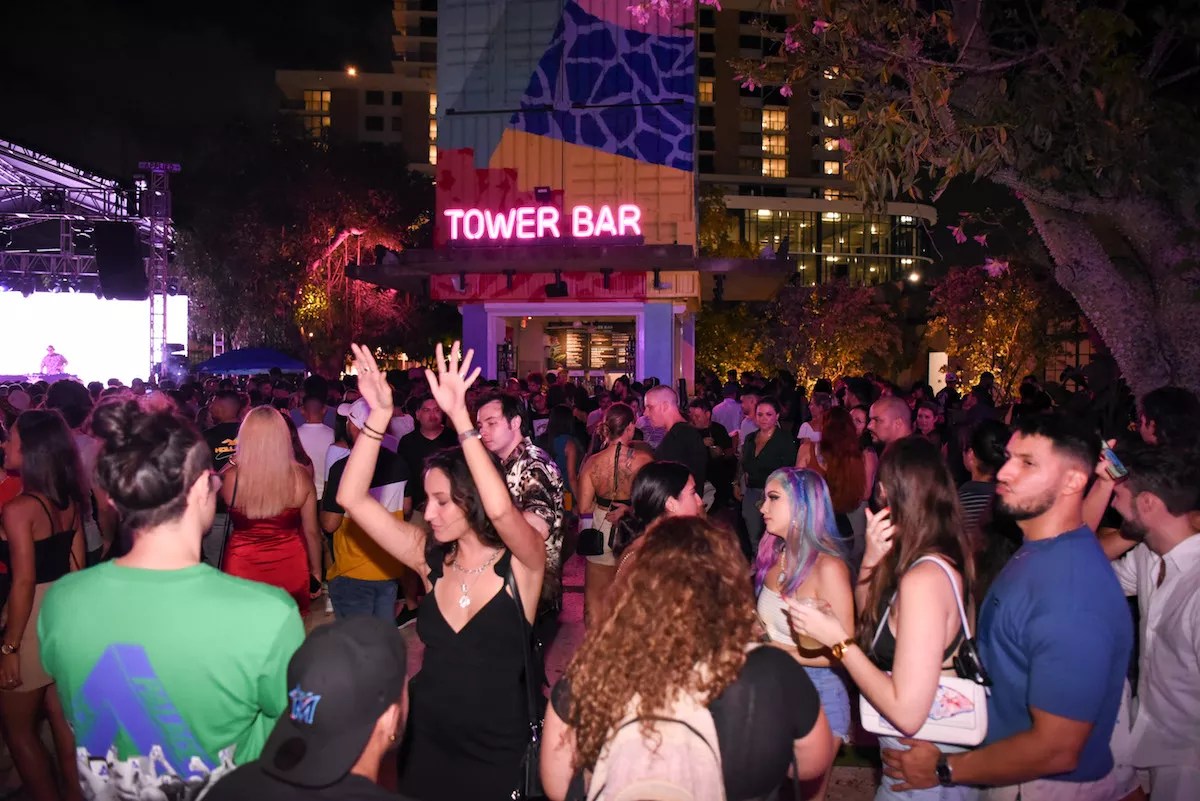
Oasis Wynwood is a spacious outdoor bar and nightlife spot. See more photos from Wynwood’s nightlife scene here.
Photo by Michele Eve Sandberg
Phase IV: Clubs
Some nightlife venues – chiefly the sleek bars and new clubs – charge a cover, some as early as 7 p.m. and some as high as $40. There are inklings that the neighborhood is becoming “the next South Beach.”
South Beach once held the title of Miami’s nightlife core, but as any local will tell you, those days are over. Part of the former party destination’s demise was its mark as a “tourist trap” and the ludicrous prices that now plague the district.
“South Beach 20 years ago was amazing,” says Philippe Kalifa, who opened El Patio in 2015, and Mayami Mexicantina in 2020, both in Wynwood. “You wanted to party, you go to South Beach. [But now], if you’re a Miamian, you don’t go to South Beach because it’s for tourists, everything is overpriced.”
Some hold out hope that Wynwood doesn’t reach the point where its progress becomes its downfall.
When Kalifa opened El Patio in 2016, his was the first Latin bar in Wynwood. Mayami debuted in October of last year as an upscale dining concept. The restaurant turns into more of a nightclub during the later hours, with dinner shows, DJs, and bottle service.
Kalifa says the key to avoiding a South Beach-like fate is balance.
“Wynwood has this multicultural huge melting pot that we need to preserve. It’s very important,” he says. “You have everything in Wynwood, from the little bar that’s going to be super affordable to the high-end restaurants. If you take this away from Wynwood, then there’s no more Wynwood.”
Mayami is among the latest nightlife spots to launch in the area, along with Le Rouge, Oasis Wynwood, and Pilo’s Tequila Garden. (Oasis also serves as Spotify’s Miami headquarters.) These establishments represent the new era of Wynwood nightlife, one that caters to a fresh crowd: a mix of tourists, locals, and new residents who moved here during the pandemic.
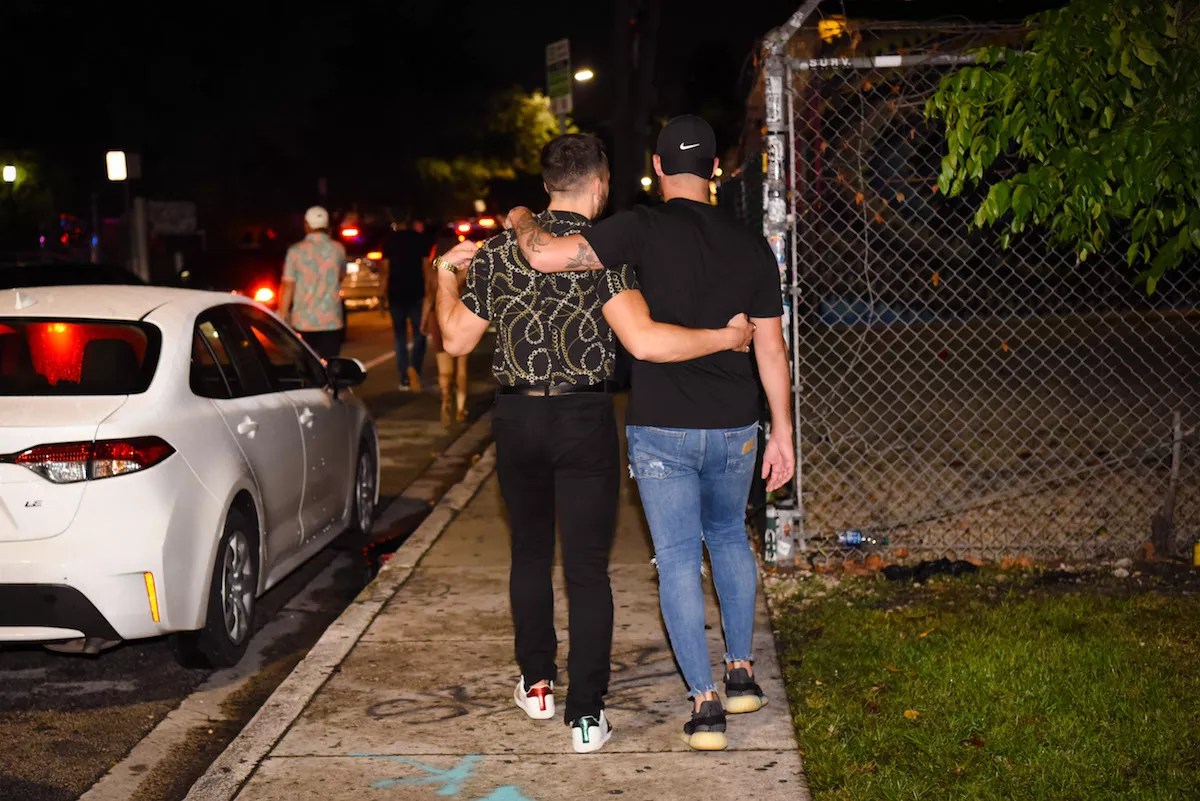
Most clubs in Wynwood have issued a “no shorts for men” mandate. See more photos from Wynwood’s nightlife scene here.
Photo by Michele Eve Sandberg
Kalifa decided to open Mayami because he felt upscale destinations were “lacking a little bit” in Wynwood.
Though his concept is high-end, he says everything is reasonably priced for what customers receive in return. Mayami’s cover runs by a system Kalifa helped create at El Patio: The money you fork over for the cover is converted to drink tickets you can use at the bar. He adds that Mayami offers three shows per night and a “great party experience.” The cover can range from $20 to $40 on the weekends, while signature cocktails cost $14 and up and beer starts at $7.
“We don’t believe in charging an entry fee and that’s it,” Kalifa says. “I don’t like that. I think that’s not right toward the client.”
In February, Pilo’s Tequila Garden opened just down SW 24th Street from Gramps, serving as the second outpost of taqueria’s original Brickell location. The spot also functions as both a restaurant and a bar, with the music getting louder and the lights getting dimmed after 10 p.m.
Pilo’s owner Derek Gonzalez had his eye on Wynwood from the start.
“The culture of the art [in Wynwood] is not something that’s a trend; it’s here to stay.”
“The culture of the art [in Wynwood] is not something that’s a trend; it’s here to stay,” Gonzalez says. “The culture of the people that come, it’s become a destination. It’s just kind of like the nucleus of culture, and I feel like 24th Street is the nucleus of the neighborhood. It’s kind of like the heart of the heart.”
Gonzalez says he kept Wynwood’s art legacy in mind when designing Pilo’s and commissioned murals inside and outside of the bar. He says he’s respectful of Wynwood’s image and that its history is important to him.
“I chose not to go vertical,” he says. “I could have monetized it much more. Every time someone comes in, it’s: ‘Why didn’t you do a rooftop? You could have done this.’ And I get it. Sometimes I’m like, ‘Man, was I a dummy for that?’ But at the same time, I’m also happy that I maintained the integrity of what [Wynwood] was while still being able to be the pioneer of what’s next.”
Like Kalifa, Gonzalez says his prices are fair. Signature cocktails start at $15 and beer at $7; the cover charge on weekends can range from $10 to $30.
“I wanted to do something for the masses. I didn’t want it to be, ‘Okay this is just something you have to pay a lot of money to get into,'” Gonzalez says.
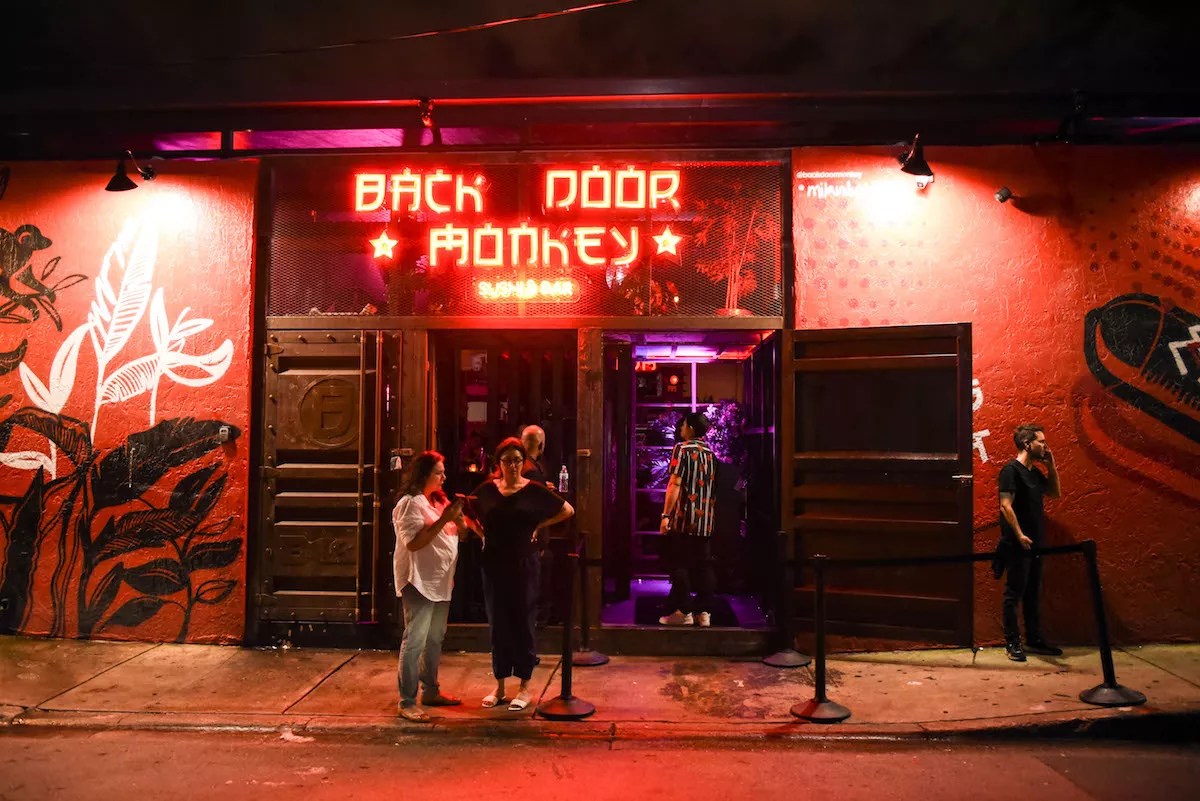
Some nightlife venues — chiefly the sleek bars and new clubs — charge a cover, some as early as 7 p.m. and some as high as . See more photos from Wynwood’s nightlife scene here.
Photo by Michele Eve Sandberg
Phase V: Residences
It’s unclear how much of Wynwood’s original charm remains. While murals still embellish the streets and some longtime businesses remain open, a lot has been revamped – from the neighborhood’s main focus, the demographic of its patrons, and its price point. And with how rapidly it has managed to evolve, there’s no telling where it will be five years down the line.
When looking toward its future, overdevelopment seems to be a worrying issue. Some of the business owners who spoke to New Times for this story said they were concerned about Wynwood being bought up by developers, becoming fully residential, and pushing out the nightlife scene.
“The city wants to help us – the owners of businesses – but I think the developers are too powerful,” says Kalifa.
In 2015, Wynwood was rezoned, an effort spearheaded by the city-run Wynwood Business Improvement District (BID) to allow the area to welcome more “residential, entertainment, and culinary options,” according to Taylor Cavazos, a senior account executive for Kivvit, a public relations firm hired by the BID. But this initiative also made the neighborhood more developer-friendly, allowing construction of residences up to 12 stories high.
The move ushered in Wywnood’s next wave. Today, 15 luxury condos and apartment buildings are under construction in the district.
“It crushes my heart because I have this crazy love for Wynwood and to make it just a fully residential city, meaningless without a soul?” Khalifa says. “Miami became this amazing entertainment cultural city. Why do we want to remove that from Miami? I don’t get it.”
When a neighborhood becomes mostly residential, issues may arise for business owners as residents file complaints about traffic and noise. Last year, Coyo Taco and the 1-800-Lucky food hall were hit with noise violations, as was Wynwood Marketplace, a spacious outdoor bar and nightlife spot.
Marketplace owner Moishe Mana, began circulating an online petition earlier this year asking residents to “Save Wynwood.”
“Recently, certain officials in Miami, under pressure and coercion from real estate developers, have taken steps to remove Wynwood’s status as an Arts & Entertainment district,” the petition reads. “Their goal is to use the momentum of this trendy neighborhood to build large luxury residential buildings and make millions in profit.”
Kalifa currently serves as president of the Wynwood Restaurant and Bar Association, a group he helped found to push back against such developers. He hopes that through the association, businesses like his can work alongside the City of Miami to show they can coexist with the incoming residential buildings.
“The point is to try to work with the officials and developers. We are going to fight this because we all poured millions of dollars into our businesses,” Kalifa says.
Kalifa does not want to pack up and move elsewhere, following in the footsteps of the low-income and minority households, gallerists, cafés, and bars before him.